Getting started with SCOUT
What's SCOUT?
SCOUT is a powerful end-to-end data technology and innovation intelligence platform that combines automated data analysis with a portfolio management system. Users can get comprehensive overviews and deep dives on any technology, trend, or organization; save all insights into projects and then collaboratively edit, evaluate, and share.
SCOUT users access MAPEGY’s Innovation Graph, a representation of the digital footprint of all innovators worldwide, by creating keyword based search queries. MAPEGY’s algorithms then extract the relevant information from the Innovation Graph to be presented within SCOUT.
Our data is updated and curated daily, and there’s no restriction on how many searches or projects you can make.
How to work with SCOUT
SCOUT has two enviroments:
- The SCOUT Hub. Explore all results for any topic or organization of your interest: Publications, Relevant Fields, Peers & Partners, Experts and Trends.
- My Portfolio. Store all relevant information to then edit, evaluate, and share your SCOUT projects.
SCOUT is a flexible tool that can be used in different ways depending on what you want to achieve and how you like to work. This article will help you start creating your portfolio, guiding you through the most important steps.
SCOUT Hub
How does searching with SCOUT work?
SCOUT is not only about exploring content. It allows you to perform comprehensive and accurate analytics like organization rankings, and display sophisticated data visualizations. In order for SCOUT to achieve that goal, we ask you to put in the little extra work and provide unambiguous queries with accurately defined scope.
Unambiguous queries. Your query should leave no room for interpretation. For example, when you enter the keyword “Apple” SCOUT needs to know whether you mean the fruit or the high-tech company. That is why you are presented with two separate search fields for topics and organizations to fill in.
Accurately defined scope. For example, in order to retrieve the best results related to the general field of “artificial intelligence”, we advise you to add relevant synonyms and highly relevant subtopics to your query, as well. You might wish to add the keywords “deep learning” or “machine learning” to your query. On the other hand, when you wish to retrieve insights on deep learning only - which is a proper subfield of artificial intelligence - you should be careful when using the keyword “artificial intelligence” since its scope is considerably broader.
How to build a query
The SCOUT query builder helps you create unambiguous and accurately defined queries so that the tool may “cut through the noise” and provide you with the most relevant insights.
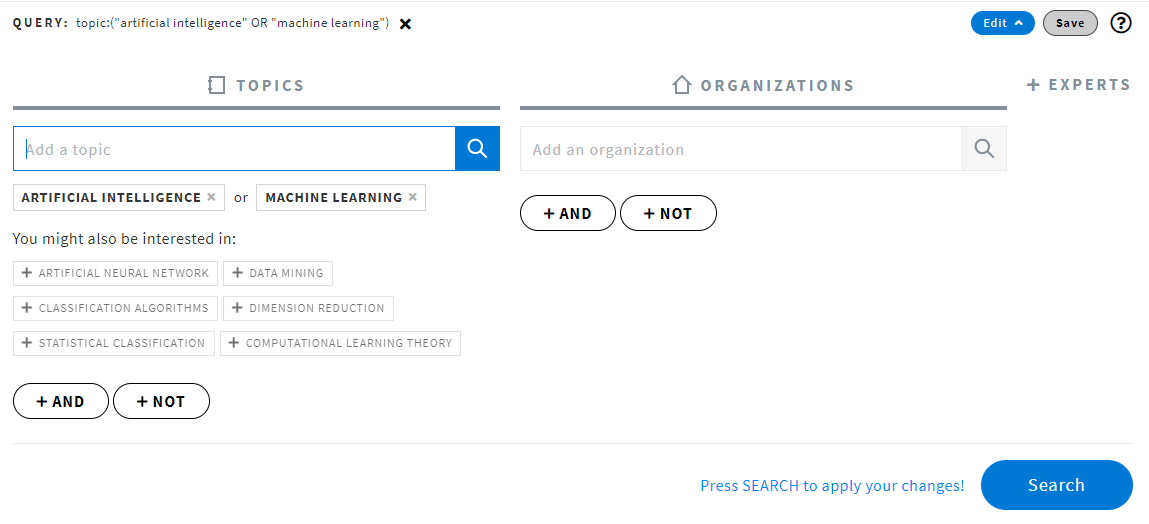
First of all, you will see that there are three different search fields for TOPICS, ("artifcial intelligence"), ORGANIZATIONS ("Google") and EXPERTS (“Elon Musk”).
- Type your search terms in the search field.
- Broaden your search by adding new terms to the search field: click on the magnifying glass or press Enter/Return if you are using your keyboard.
- Narrow your search by adding additional search fields with the (+ AND ) / ( + NOT ) buttons.
- Finally, click on the ( Search ) button to start the analysis and display the results.
Boolean Operators. You may notice that SCOUT translates your query into a form which involves what is called Boolean operators:
- The OR operator broadens your query’s scope.
“artificial intelligence” OR “machine learning” OR “deep learning”
This means that any document matching at least one of the keywords is used for analysis.
If you click on Search now, SCOUT will perform analytics based on those three keywords. For many use cases and quick analyses, these kinds of searches already provide enough expressive power. - The AND operator narrows down your query’s scope.
(“artificial intelligence” OR “machine learning” OR “deep learning”) AND (“medical imaging”)
This means that documents and entities that match both queries on either side of the “AND” are being used for analysis, and only those documents and entities.
You may add new relevant keywords to “medical imaging” in order to more accurately define the new scope of your query:
(“artificial intelligence” OR “machine learning” OR “deep learning”) AND (“medical imaging” OR "magnetic resonance imaging") - The AND NOT operator excludes fields of interest.
(“artificial intelligence” OR “machine learning” OR “deep learning”) AND (“medical imaging” OR "magnetic resonance imaging") AND NOT (“x-ray”)
This means that documents containing the keyword “x-ray” in the description will be excluded from the analysis.
How to save a query
- You can save your query to a SCOUT Project by clicking on the ( Save ) button.

- A dialog will pop up so you can choose where to save your query:
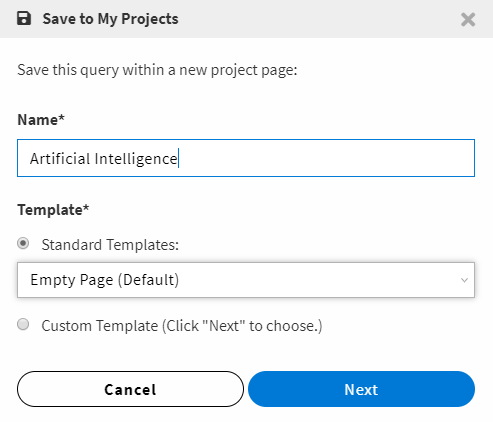
Results
After clicking on the ( Search ) button, you will be redirected to your query results. Results are divided into 6 tabs: Overview, Publications, Relevant Fields, Peers & Partners, Experts and Trends. Each of these tabs, except for the Overview, contains different panels (tables or visualizations).
We recommend having a look at these resources in order to get a full understanding of SCOUT results and indicators: Overview Panel | Publications | Relevant Fields | Peers & Partners | Trends.
How to save results
From your search results, you can save or share relevant information in different ways:
- by saving the query and SCOUT Panels as a SCOUT Project page.
- by exporting complete datasets or visualizations as a downloadable file. Click on the Export data button and select your preferred file format: png, .csv, .ods, .xls, .xlsx.
- by bookmarking single elements such as publications, topics, organizations, or experts.
- To bookmark, select the checkbox on the element that you would like to bookmark.

- In addition to rows and tiles in rankings and publication lists, you may also bookmark the references that you can access when you expand a table row.
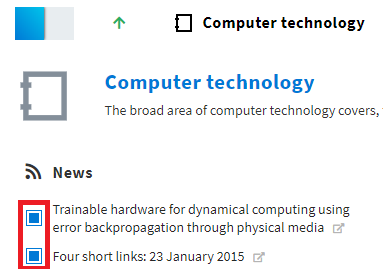
- Select an existing SCOUT Project, Project page, or Project subpage where you wish to save your bookmark, or create a new SCOUT Project.
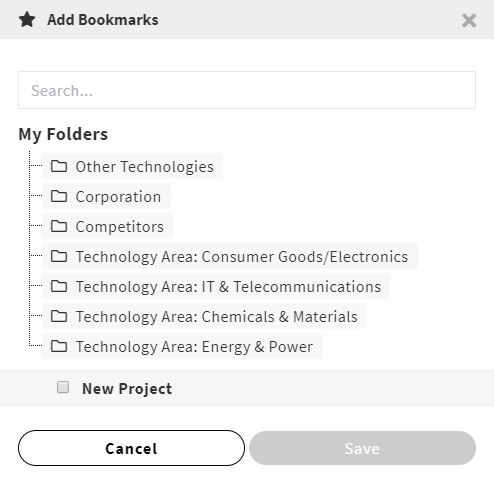
- Go to the SCOUT Project and select the bookmark type. You will now have created new bookmarks.

My Portfolio
Create a new Project
You can create SCOUT Projects in different ways:
- by bookmarking,
- by saving your query,
- by clicking on the New project button.some text
- On My Portfolio page, click on
- Select the SCOUT template you want to use for your new project.
- Run your search and click on Create Project.
- by using an existing project query.some text
- Right click on the first page of your project.
- Select Copy pages and subpages.
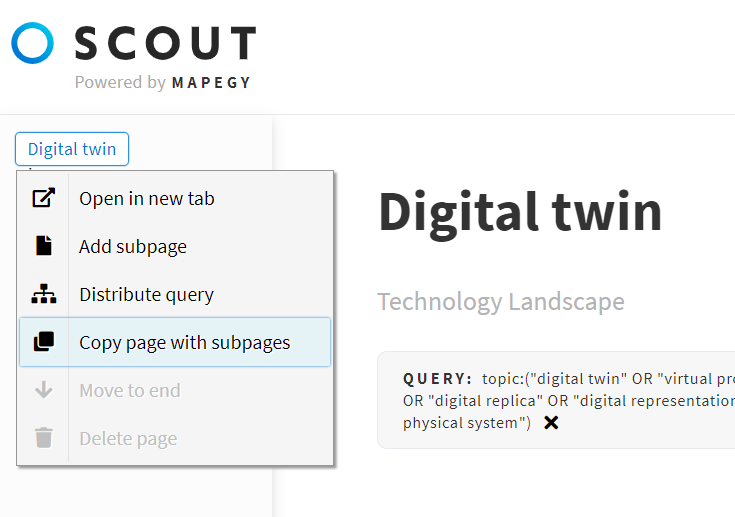
Edit Projects
SCOUT allows you to add pages, subpages, and content to your SCOUT Projects.
Add pages and subpages
On the left hand side of your project, you can see the outline (pages and subpages) of your project. Add subpages to your main project page by right clicking on your SCOUT project’s main page.
You can also add further pages to each SCOUT Project subpage. Adding a subpage to a page will copy that page’s query into it. However, each page is assigned an individual query. If you edit the query of that specific page, it will not affect the other pages.
Add and edit content
SCOUT Projects always open in ‘read only’ to avoid accidental edits.To start editing, click on the blue icon on the upper right part of the page.
- To save your changes, click on
- To discard your changes, click on
Types of content
When in editing mode, simply click on one of the icons to add content. Read more on SCOUT Projects Functionalities and Project queries.
Evaluate Projects
SCOUT allows you to evaluate your SCOUT Projects by using two different sets of indicators: MAPEGY indicators and User indicators. These indicators will appear in My Porfolio so you can compare your SCOUT Projects.
MAPEGY indicators
When you create a project with a query or change (and save) the query of a project, MAPEGY indicators are added/updated in the My Portfolio table. These automated indicators are automatically updated once a month.

If you have entered a topic query, at the top of the Overview Panel you will see the following three KPIs: Established companies, Startup funding and Research funding. For organization queries, these indicators will not be displayed.
Furthermore, the following three KPIs will be displayed for topic, organization and expert queries: News, Research, Patents.
Be sure you read this article to interpret MAPEGY indicators correctly.
User indicators
Additionally, you can evaluate your projects, by using your curated indicators: Market Potential, Technology Maturity, Risk, Cost, Strategic Fict, Internal Know-How, and STATUS.
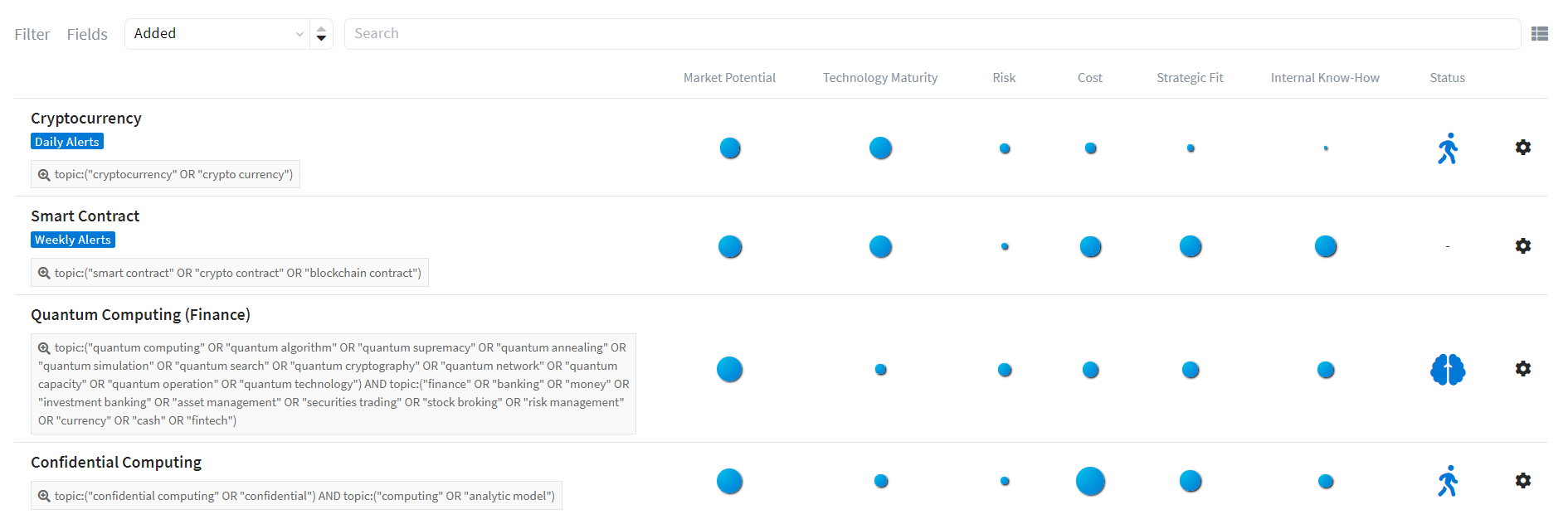
- Open the SCOUT Project you need to evaluate.
- Click on Add evaluation or on the blue icon on the upper right part of the page.
- Add or edit your evaluation by clicking on the indicators.
- Click on Save.

Share Projects
SCOUT Projects can be shared in different ways:
- by sharing it with your SCOUT User group
- As SCOUT Group admin: To share a SCOUT project with all members of your SCOUT User Group so that they can see it in My Portfolio and work on it, click on the Sharing button. To disable sharing option, click on the Unshare button. This way, your project will be only visible in My Portfolio.
- As SCOUT Group member: To share a SCOUT project with all members of your SCOUT User Group so that they can see it in My Portfolio and work on it, click on the Change owner button and choose your SCOUT group, in order to transfer the ownership to your group admin. Your transferred project will be right away visible within your whole ecosystem.
- by sharing a SCOUT project link. Inside SCOUT projects, click on the Get a shareable link button. You can then select expiration date or add a password if needed. Note that unprotected SCOUT projects that are shared publicly may be indexable by search engines.
- by exporting pdf. Inside SCOUT Projects, click on Export pdf.
- by using the Presentation mode. Inside SCOUT Projects, click on Start Presentation.
Radar
You can also use the Radar visualization in order to analyze, evaluate, and visualize your SCOUT Projects.
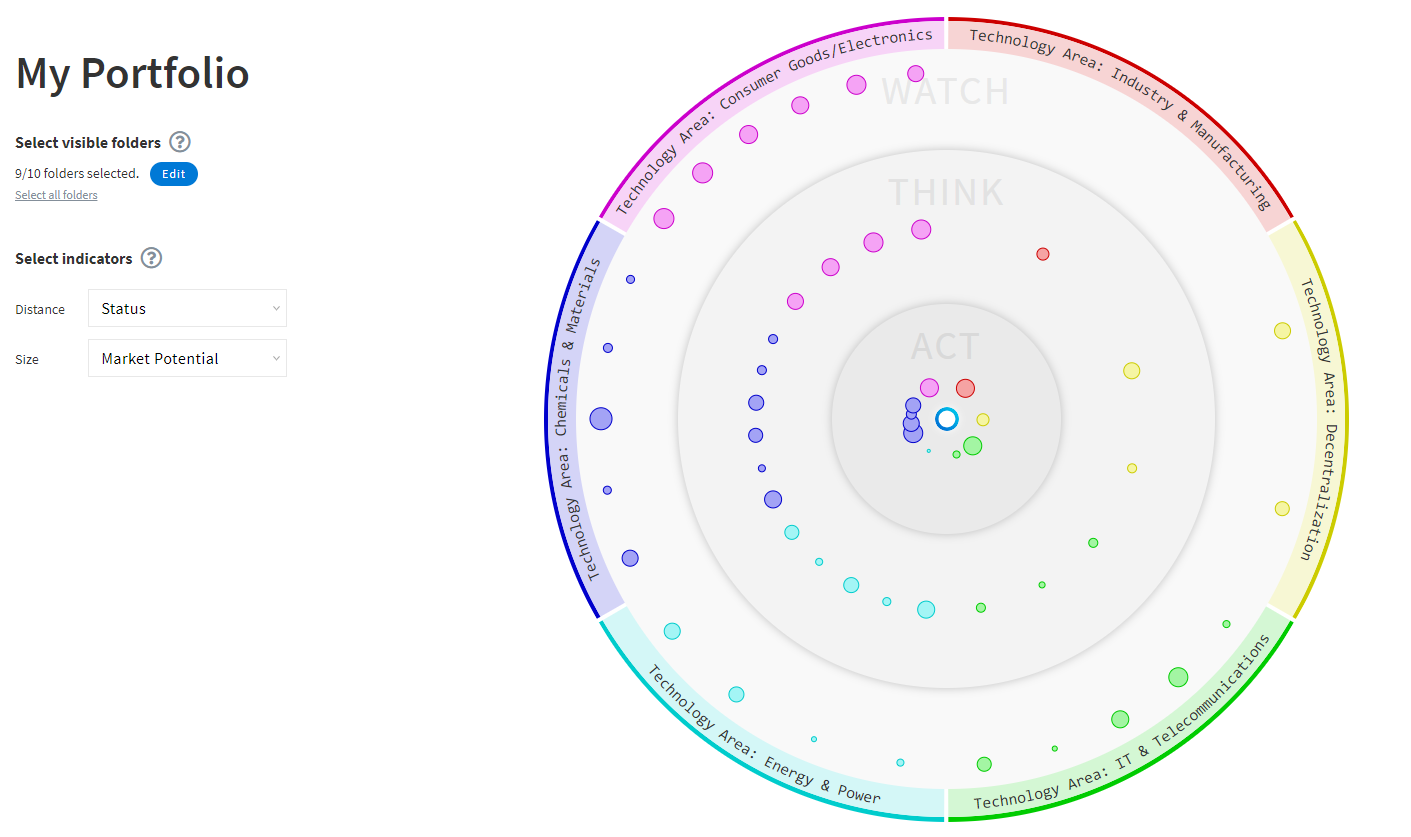
- Select which folders you want to be displayed. Only folders containing SCOUT Projects that provide the selected indicators will be displayed.
Folders are represented by a colored sector and SCOUT projects by dots. - Select indicators. Choose how you want to visualize your SCOUT Projects.
- Distance. Select which indicator you would like to use to display the distance of the dot to the center of the radar.
- Size. Select the meaning of the size of the dot.
Don't miss out!
Email alerts can be activated for your SCOUT Projects. Get regular notifications about all newly identified publications (news articles, patents, and scientific publications) related to your saved query.
- In My Portfolio, click on the Enable alerts button to toggle alerts on. You can then decide if you want to be notified weekly or daily.
- To unsubscribe from alerts, click on the Unable alerts button.
- You will be notified by email about new alerts. You can also visit your Alerts Overview.


.svg)